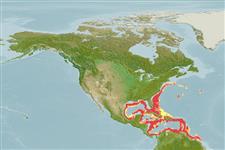Malacostraca |
Decapoda |
Solenoceridae
Environment: milieu / climate zone / depth range / distribution range
Ecology
Benthic; depth range 180 - 1850 m (Ref. 106153), usually 180 - 730 m (Ref. 101581). Subtropical; 7°C - 13°C (Ref. 8), preferred 22°C (Ref. 107945); 41°N - 4°N, 98°W - 51°W (Ref. 115944)
Western Central Atlantic: USA to French Guiana. Tropical to temperate.
Length at first maturity / Size / Weight / Age
Maturity: Lm ? range ? - ? cm Max length : 18.0 cm TL male/unsexed; (Ref. 98); 22.5 cm TL (female); common length : 13.0 cm TL male/unsexed; (Ref. 98)
Maximum carapace length: 4.2 cm (male); 6.15 cm (female; Ref. 86). Minimum depth from Ref. 106927. Lives in the continental shelf from depths of 180 to 730 m; abundant from depths of 250 to 475 m. Inhabits mud, sand, muddy sand, or white calcareous mud (Ref. 106927).
Life cycle and mating behavior
Maturity | Reproduction | Spawning | Eggs | Fecundity | Larvae
Members of the order Decapoda are mostly gonochoric. Mating behavior: Precopulatory courtship ritual is common (through olfactory and tactile cues); usually indirect sperm transfer.
Holthuis, L.B. 1980 FAO Species Catalogue. Vol. 1. Shrimps and prawns of the world. An annotated catalogue of species of interest to fisheries. FAO Fish. Synop. 125(1):271 p. Rome: FAO. (Ref. 8)
IUCN Red List Status
(Ref. 130435: Version 2025-1)
CITES status (Ref. 108899)
Not Evaluated
Not Evaluated
Threat to humans
Human uses
Fisheries: commercial
FAO - Fisheries: landings | FIRMS (Stock assessments) | FishSource | Sea Around Us
Tools
More information
Trophic EcologyFood items (preys)Diet compositionFood consumptionPredators Life cycleReproductionMaturityFecunditySpawningEggsEgg developmentLarvae PhysiologyOxygen consumption
Human RelatedStamps, coins, misc.
Internet sources
Estimates based on models
Preferred temperature
(Ref.
115969): 8.4 - 18, mean 12 (based on 144 cells).
Resilience
High, minimum population doubling time less than 15 months (K=0.39).
Fishing Vulnerability
Low to moderate vulnerability (30 of 100).
Climate Vulnerability
Low to moderate vulnerability (26 of 100).
Nutrients : Calcium = 109 [35, 184] mg/100g; Iron = 1.59 [1.21, 1.97] mg/100g; Protein = 20.2 [19.2, 21.3] %; Omega3 = 0.285 [0.185, 0.386] g/100g; Selenium = 48.3 [-31.7, 128.3] μg/100g; VitaminA = 0 μg/100g; Zinc = 1.79 [1.17, 2.40] mg/100g (wet weight); based on
nutrient studies.
